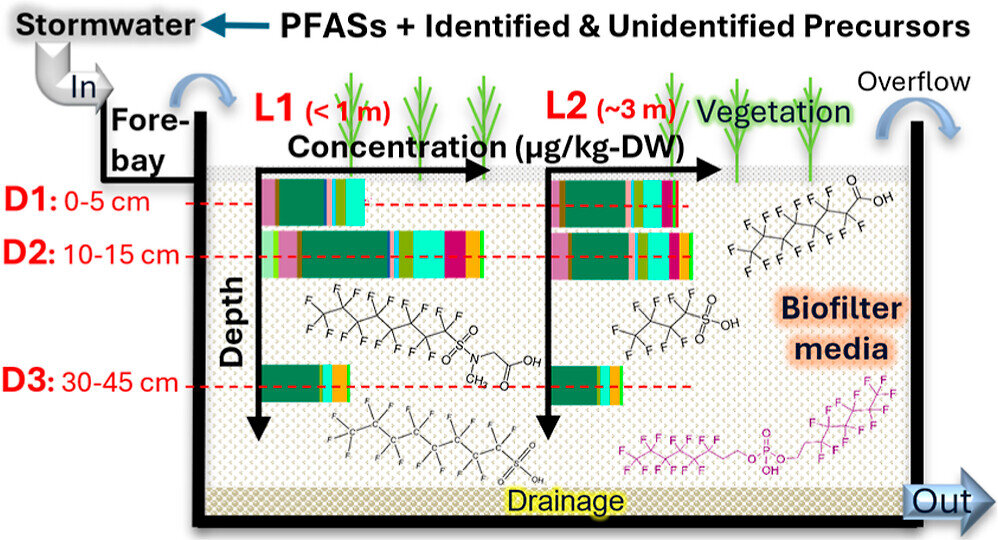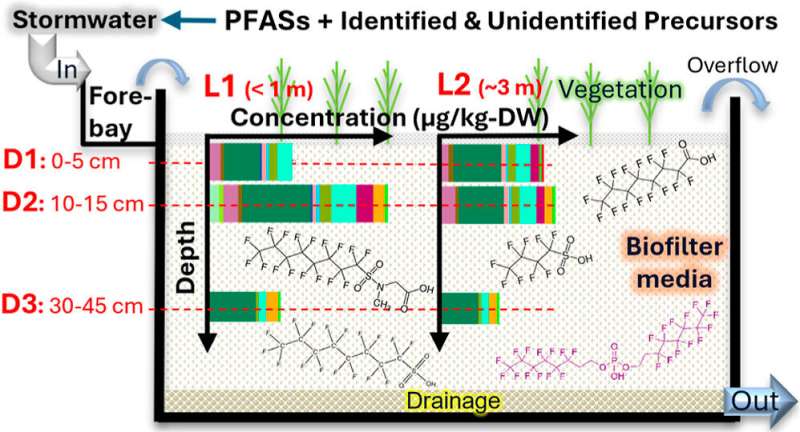

In collaboration with researchers at Ohio State University and the Swedish construction company NCC, researchers in Urban Water Engineering at Luleå University of Technology have conducted a comprehensive study on the occurrence, concentration and distribution of PFAS in urban biofilter facilities treating stormwater.
This type of treatment facility is increasingly implemented worldwide when new industrial and residential urban areas are planned. Consequently, the maintenance issue has become more and more important.
“We have found considerable quantities of PFAS in most of the biofilter facilities we have studied. In contrast to, for instance, metals captured high up in the biofilter facilities, PFAS were unevenly distributed in all filter layers, even at the very bottom of the filter materials, which are rarely replaced.
“These results may have a great impact on the understanding of treatment processes and future operation and maintenance of biofilter facilities,” says Ali Beryani, doctoral student in Urban Water Engineering at Luleå University of Technology.
The study is published in Environmental Science & Technology.
Relatively few scientific long-term studies have been conducted on urban biofilter facilities around the world, and the number of facilities analyzed has not been as high as in the present study. The researchers have studied 20 biofilter facilities in Ohio, Michigan and Kentucky, U.S., which have been operational for a long time, between eight and 16 years.
The U.S. provides an opportunity to conduct such studies since the country is a forerunner when it comes to biofilter implementation for stormwater treatment. Moreover, analyzing the occurrence and concentration of 35 PFAS and their precursors (chemical PFAS compounds that, via a chemical reaction, may produce other PFAS compounds that are easier to analyze) in the facilities makes the study one of a kind.
The number of biofilter facilities for stormwater treatment is increasing worldwide, not least in Sweden where thousands of this kind of facility exist, which means that the interest in how operation and maintenance should be carried out is also increasing.
The purpose of these biofilters is to capture various pollutants, but the biofilters do not eliminate them. Instead, most pollutants accumulate in the treatment filters, which need maintenance and filter material replacement.
Biofilter design is based on the same principle all over the world. Therefore, the results of this study are applicable in most countries. There were no known PFAS emission point sources in the catchment areas of the treatment facilities that were included in the study. Measured PFAS originated from regular urban stormwater discharges.
In biofilter facilities, stormwater is filtered through filter materials that basically consist of a soil and/or sand layer that can be up to 1 meter (approximately 2.5–3 feet) thick. At the bottom, there is a drainage system that collects the treated water which then is discharged to the storm sewer system and after that to receiving water bodies.
Without such treatment, the untreated stormwater is directly discharged to the same water bodies where we take baths and go fishing and use it as a drinking water supply.
Stormwater biofilters effectively remove most metals. The facilities, on the other hand, are not built for removing PFAS, since the occurrence of PFAS in stormwater has only been noticed in recent years. Today, however, we know that there are PFAS in stormwater and thus also in these treatment facilities. But what do occurrence, concentration and distribution of PFAS look like in the biofilters?
Regarding pollutants such as metals from road traffic, the researchers show in the study that the largest quantity is found in the top layer, that is, approximately the top 10 centimeters of the filter material, as expected. This suggests that a replacement of these 10 centimeters when maintaining the facility is enough to re-establish most of the biofilter function.
But PFAS show a different pattern. The researchers observed in the study that PFAS are distributed much more unevenly in the filter material than other pollutants. Many PFAS are more water soluble, also known as hydrophilic pollutants. Thus, they are not as easily or not at all absorbed by the filter material.
In the study, the researchers have used a new method for this kind of study, TOP Assay oxidation, to identify different and more types of the very high number of PFAS.
“In the biofilter facilities that we have studied, we have found both short-chain and long-chain PFAS in the sediments. Long-chain PFAS are a particular concern due to their very long half-life, higher toxicity and risk of bioaccumulation, whereas the short-chain molecules are less toxic but more soluble and mobile in aquatic environments,” says Beryani.
The occurrence of PFAS in society is a major concern due to their detrimental effects on the environment and human health. PFAS degrade very slowly and are thus called “forever chemicals.”
Their high solubility and mobility in aquatic environments contribute to their long-lasting circulation in aquatic environments. Several states in America and also in the EU have listed some PFAS as being banned or restricted for use. Despite this, these substances will be found in the environment for a long time due to their slow degradation.
Robert Furén, industrial doctoral student at the construction company NCC, participated in the study, not least because operation and maintenance of biofilter facilities will be more and more important, since the number of this kind of treatment facility increases when new urban development plans are developed.
“Nowadays, the top layer in a biofilter facility is replaced during maintenance to recover infiltration rates and to reduce the risk of leakage of pollutants. Our study indicates that in the long run, it is not enough to simply remove this top layer, taking into account the occurrence of more soluble organic substances, for example certain PFAS. The results demonstrate the importance of depositing sand and layers of soil from the biofilter facilities in a secure way,” says Furén.
More information:
Ali Beryani et al, Occurrence, Concentration, and Distribution of 35 PFASs and Their Precursors Retained in 20 Stormwater Biofilters, Environmental Science & Technology (2024). DOI: 10.1021/acs.est.4c05170
Provided by
Lulea University of Technology
Citation:
Study find high occurrence of PFAS in biofilters for stormwater treatment (2024, October 14)
retrieved 15 October 2024
from https://phys.org/news/2024-10-high-occurrence-pfas-biofilters-stormwater.html
This document is subject to copyright. Apart from any fair dealing for the purpose of private study or research, no
part may be reproduced without the written permission. The content is provided for information purposes only.